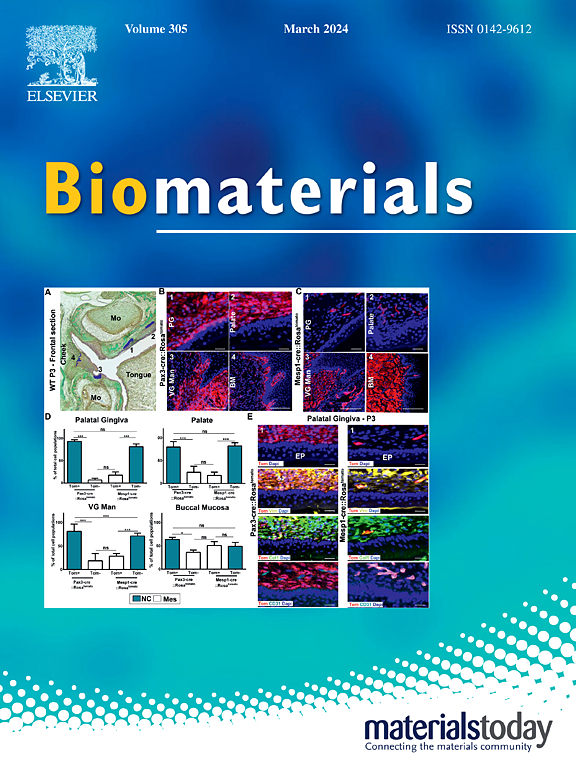Engineered macroporous gelatin scaffolds enhance lymph node fibroblastic reticular cell identity and enable diabetogenic T cell immunomodulation
IF 12.9
1区 医学
Q1 ENGINEERING, BIOMEDICAL
引用次数: 0
Abstract
Current treatments for autoimmune diseases like Type 1 Diabetes (T1D) carry significant risks because they lack tissue specificity. A promising strategy is to achieve persistent presentation of relevant antigens (Ags) in non-inflamed sites by tolerogenic Ag-presenting cells (APCs) like fibroblastic reticular cells (FRCs). FRCs build lymph node (LN) reticula and act as immunomodulatory non-professional APCs. However, their therapeutic potential for Ag-specific immunomodulation for T1D remains unexplored. We engineered 3D FRC-based reticula using freeze-dried macroporous gelatin scaffolds with customizable pore diameters (small: <50 μm, medium: <200 μm, large: <300 μm) to evaluate FRC phenotype and FRC-T cell interactions, leveraging FRCs’ ability to build dynamic LN reticula that expand and contract during inflammation. Our scaffolds promoted FRC viability, reticular formation, FRC phenotypic marker expression, and extracellular matrix secretion compared to 2D culture. GFP-Luciferase fusion (GLF)-expressing FRCs subcutaneously implanted in our scaffolds survived for at least 21 days regardless of pore size. Implantation in the vascularized fat pad led to graft rejection by day 14 in pre-diabetic NOD mice but not in immunodeficient NODscid. Our scaffolds outperformed clinically-used biologic gels, demonstrated the limitations of the NOD mouse model in longitudinal imaging of GLF+ cell survival, and validated our scaffold-based FRC delivery approach for future therapeutic applications. Co-culture of T cells in scaffolds with FRCs presenting T1D Ags enabled Ag-specific T cell engagement with reduced cytotoxic and increased anergic and regulatory phenotypes. Our results validate the use of macroporous gelatin scaffolds to enhance FRC phenotypic markers, in vivo survival, and diabetogenic cell immunomodulation in vitro.
工程大孔明胶支架增强淋巴结成纤维网状细胞的身份,并使糖尿病T细胞免疫调节
目前对自身免疫性疾病(如1型糖尿病(T1D))的治疗存在显著风险,因为它们缺乏组织特异性。一种很有前景的策略是通过耐受性抗原呈递细胞(APCs)如成纤维网状细胞(FRCs)在非炎症部位实现相关抗原(Ags)的持续呈递。FRCs构建淋巴结网,作为免疫调节的非专业APCs。然而,它们对银特异性免疫调节T1D的治疗潜力仍未被探索。我们使用可定制孔径(小孔径:50 μm,中孔径:200 μm,大孔径:300 μm)的冻干大孔明胶支架设计了基于FRC的3D网状结构,以评估FRC表型和FRC- t细胞相互作用,利用FRC构建在炎症期间扩张和收缩的动态LN网状结构的能力。与2D培养相比,我们的支架可促进FRC活力、网状结构形成、FRC表型标志物表达和细胞外基质分泌。无论孔径大小如何,在我们的支架中皮下植入表达gfp -荧光素酶融合(GLF)的FRCs至少存活了21天。在糖尿病前期NOD小鼠中,血管化脂肪垫的植入导致了第14天的移植排斥反应,而在免疫缺陷的NODscid中则没有。我们的支架优于临床使用的生物凝胶,证明了NOD小鼠模型在GLF+细胞存活纵向成像方面的局限性,并验证了我们基于支架的FRC递送方法在未来治疗中的应用。T细胞与呈递T1D Ags的FRCs在支架中共培养,使ag特异性T细胞参与,细胞毒性降低,无能和调节性表型增加。我们的研究结果验证了大孔明胶支架在体外增强FRC表型标记、体内存活和糖尿病细胞免疫调节方面的作用。
本文章由计算机程序翻译,如有差异,请以英文原文为准。
求助全文
约1分钟内获得全文
求助全文
来源期刊

Biomaterials
工程技术-材料科学:生物材料
CiteScore
26.00
自引率
2.90%
发文量
565
审稿时长
46 days
期刊介绍:
Biomaterials is an international journal covering the science and clinical application of biomaterials. A biomaterial is now defined as a substance that has been engineered to take a form which, alone or as part of a complex system, is used to direct, by control of interactions with components of living systems, the course of any therapeutic or diagnostic procedure. It is the aim of the journal to provide a peer-reviewed forum for the publication of original papers and authoritative review and opinion papers dealing with the most important issues facing the use of biomaterials in clinical practice. The scope of the journal covers the wide range of physical, biological and chemical sciences that underpin the design of biomaterials and the clinical disciplines in which they are used. These sciences include polymer synthesis and characterization, drug and gene vector design, the biology of the host response, immunology and toxicology and self assembly at the nanoscale. Clinical applications include the therapies of medical technology and regenerative medicine in all clinical disciplines, and diagnostic systems that reply on innovative contrast and sensing agents. The journal is relevant to areas such as cancer diagnosis and therapy, implantable devices, drug delivery systems, gene vectors, bionanotechnology and tissue engineering.
 求助内容:
求助内容: 应助结果提醒方式:
应助结果提醒方式:


